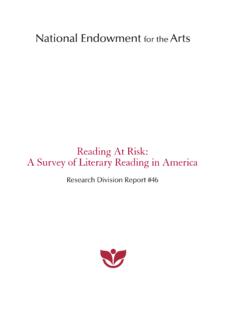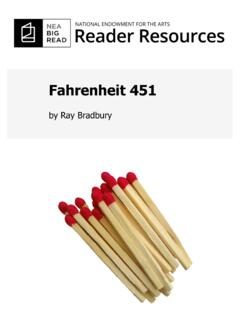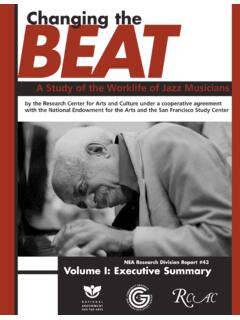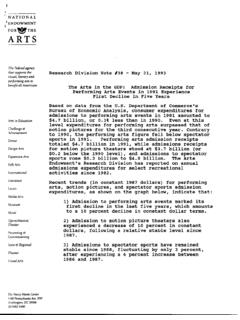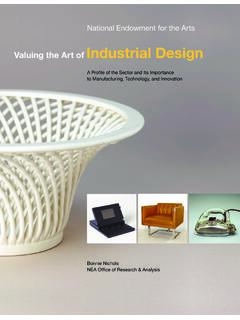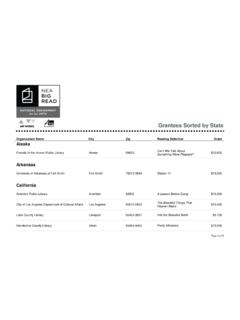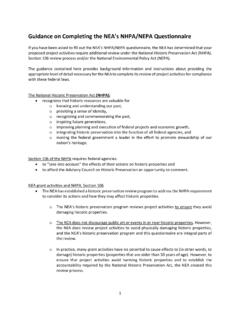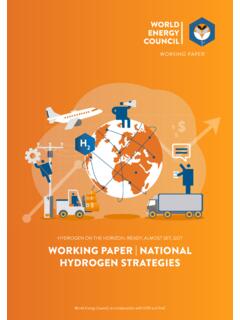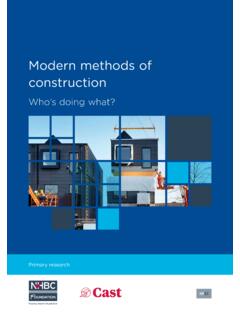Transcription of Creative Placemaking Paper - National Endowment for the …
1 A white Paper for The Mayors Institute on City Design, a leadership initiative of the National Endowment for the Arts in partnership with the United States Conference of Mayors and American Architectural PlacemakingAnn Markusen Markusen Economic Research ServicesAnne Gadwa Metris Arts ConsultingEXECUTIVE SUMMARYC reative PlacemakingAnn Markusen, Markusen Economic Research Services and Anne Gadwa, Metris Arts ConsultingThis white Paper is for The mayors institute on city Design, a leadership initiative of the National Endowment for the arts in partnership with the United States conference of mayors and american architectural Foundation. markusen economic Research Services and metris arts consulting, 2010 Designed by Hirshorn Zuckerman Design group, inc.
2 , view or download this free report, go to Pennsylvania Avenue, NWWashington, DC 20506-0001(202) 682-5400 Creative PlACEMAkIng3 Creative Placemaking : EXECUTIVE SUMMARYIn Creative Placemaking , partners from public, private, non-profit, and community sectors strategically shape the physical and social character of a neighborhood, town, city, or region around arts and cultural activities. Creative Placemaking animates public and private spaces, rejuvenates structures and streetscapes, improves local business viability and public safety, and brings diverse people together to celebrate, inspire, and be inspired. in turn, these Creative locales foster entrepreneurs and cultural industries that generate jobs and income, spin off new products and services, and attract and retain unrelated businesses and skilled workers.
3 Together, Creative Placemaking s livability and economic development outcomes have the potential to radically change the future of american towns and of a single arts center or a cluster of large arts and cultural institutions, contemporary Creative Placemaking envisions a more decentralized portfolio of spaces acting as Creative crucibles. in each, arts and culture exist cheek-by-jowl with private sector export and retail businesses and mixed-income housing, often occupying buildings and lots that had been vacant and under-used. in large cities, many such hubs reflect the ethnic or historical character of place and invite residents and visitors alike across porous boundaries to visit, patronize, and enjoy. in smaller towns, traditional cultural practices and landscapes are transformed into distinctive cultural centers and festivals that revive emptying downtowns and attract regional visitors.
4 Large cultural institutions, often inspired by their smaller counterparts, are increasingly engaging in active white Paper summarizes two decades of Creative american Placemaking , drawing on original economic research and case studies of pathbreaking initiatives in large and small cities, metropolitan to rural, as well as published accounts. The case studies stretch from Providence, Rhode island, to los angeles, california, and The Problem: American c iti es, s uburbs, and s mal l towns confront str uctural c hange and residential uprooting The Solution: Revita lizat ion by c reative initi atives t hat animate p laces and spark economic devel-opment. The Payoffs: Gai ns i n livability, diversity, jobs and in-comes Innovat ive products a nd s ervi ces f or the cul tural i ndustr ies THE PROBLEMAMERICAN CITIES, SUBURBS, AND SMALL TOWNS CONFRONT STRUCTURAL CHANGES AND RESIDENTIAL UPROOTINGTHE PAYOFFSGAINS IN LIVABILITY, DIVERSITY, JOBS AND INCOMESINNOVATIVE PRODUCTS AND SERVICES FOR THE CULTURAL INDUSTRIESTHE SOLUTIONREVITALIZATION BY Creative INITIATIVES THAT ANIMATE PLACES AND SPARK ECONOMIC DEVELOPMENTCREATIVE PlACEMAkIng4 Creative E ConoMIES HoST 2 million artists million cultural workers million cultural industry jobsCREATIVE Placemaking FoSTERS E ConoMIC DEVEloPMEnT Recirculates residents incomes locally at a higher rate Re-uses vacant and underutilized land.
5 Buildings, and infrastructure Creates jobs in construction, local businesses, and cultural activity Expands entrepreneurial ranks of artists and designers Trains the next generation of cultural workers Attracts and retains non-arts-related businesses and skillsCASES oF Creative Placemaking Three Cleveland west-side theatres, one owned by a community development corporation, lead the redevelopment of a commercial corridor as Gordon Square Arts District. Buffalo s Mayor and a non-profit arts developer transform a vacant auto plant into artist studios and housing, infusing the neighborhood with Creative and economic activity. Portland s new transit stations incorporate artwork that reflects distinctive neighborhoods and encourages ridership.
6 San Jos s 01SJ Biennial marries art and technology to generate new products, bring people downtown, and showcase the City s Placemaking FoSTERS AMERICAn lEADERSHIP In globAll Y CoMPETITIVE InDUSTRIES Movies Broadcasting Publishing News media Musical recordings and video Social media Advertising Design services Architecture Video gamesCREATIVE PlACEMAkIng5from arnaudville, louisiana, and Fond du lac, minnesota, to Seattle, Washington. each reveals a distinctive strategy that succeeded when initiators built partnerships across sectors, missions, and levels of government, leveraging funds from diverse sources and Placemaking serves livability, diversity, and economic development goals. livability outcomes include heightened public safety, community identity, environmental quality, increased affordable housing and workplace options for Creative workers, more beautiful and reliable transportation choices, and increased collaboration between civic, non-profit, and for-profit partners.
7 Economic development quickens because arts and cultural investments help a locality capture a higher share of expenditures from local income. instead of traveling elsewhere for entertainment and culture, or going to a big-box retailer or shopping mall, residents are patrons of local talent and venues, earnings that re-circulate at a higher rate in the local economy. Re-using vacant space generates local property and sales tax revenues that can be devoted to streets, lighting, sanitation, greenery, and police and fire. additional jobs and incomes are generated in construction, retail businesses, and arts and cultural production . new businesses, in the Creative industries and others, are attracted to these has always been important for the emergence of new products, industries, and jobs.
8 We find that Creative places are cultural industry crucibles where people, ideas, and organizations come together, generating new products, industries, jobs, and american exports. They nurture entrepreneurs and expand the ranks of self-employed artists and designers who market their creations far afield. Training grounds for area youth, they incubate the next generation of Creative workers and entrepreneurs. Because jobs increasingly follow people, rather than vice versa, they draw and retain other businesses and workers to their rich, lively, and diverse cultural industry incubators, Creative places make valuable contributions to the National economy. more than 2 million americans support themselves as artists, and the ranks of cultural workers exceed million, or almost 3% of the nation s workforce .
9 Many are entrepreneurs, some employ others; 65% of writers, 57% of visual artists, and 41% of musicians are and related cultural workers provide the core expertise for american cultural industries, supporting close to 5 million jobs. These industries the performing arts, movies, television, broadcasting, sound recording, video games, design, advertising, publishing, tourism are among our most competitive internationally, producing billions of dollars in export placemakers confront daunting challenges. many have stumbled along the way. Others have been slowed down or suffer growing pains. We asked leaders of successful efforts about the challenges they faced, how they met them, and what lessons they learned. in addition to overcoming fiscal challenges stemming from the great Recession, many Creative placemakers have navigated similar obstacles, namely: difficulties in creating partnerships, countering skepticism on the part of communities and public leaders, assembling adequate financing, clearing regulatory hurdles, ensuring long-term maintenance and sustainability, avoiding displacement and gentrification, documenting progress, and developing performance metrics.
10 These insights are as important as their achievements for informing policy and encouraging other the United States, Creative Placemaking operates at all geographic scales and with a diverse array of initiators and partners. We identify six components of a successful strategy, drawn from in-depth interviews. each effort starts with an entrepreneurial initiator; demonstrates a commitment to place and its distinctive character; mobilizes public will, both in local government and the citizenry; attracts private sector Challenges for Creative Placemaking Forging partnerships Countering community skepticism Assembling adequate financing Clearing regulatory hurdles Ensuring maintenance and sustainability Avoiding displacement and gentrification Developing metrics of performancesuCCessful Creative Placemaking Prompted by an initiator with innovative vision and drive Tailors strategy to distinctive features of place Mobilizes public will Attracts private sector buy-in Enjoys support of local arts and cultural leaders Builds partnerships across sectors, missions, and levels of governmentCREATIVE PlACEMAkIng6support, either from cultural industries or place developers or both.

